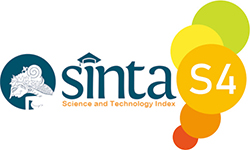PENGARUH TQM TERHADAP KEUNGGULAN BERSAING YANG DIMEDIASI OLEH RESOURCE BASED VIEW PADA PERUSAHAAN PENGOLAHAN IKAN DI KOTA BITUNG
DOI:
https://doi.org/10.35794/jmbi.v11i1.54404Abstract
Abstract. Bitung City has the largest fishing industry in North Sulawesi. Fish processing companies in Bitung City are mostly fish exporting companies that are sent to various countries. This condition presents its own challenges because it allows companies to strive to have a competitive advantage. Implementing TQM (Total Quality Management) for export companies is a must. However, to be able to excel competitively requires unique entities within the company. RBV (Resource Based View) describes a company's ability to provide a competitive advantage in resource management that is difficult for competitors to imitate. The aim of the research is to determine the effect of TQM on Competitive Advantage with RBV as a mediating variable. Based on the test results using SmartPls4.0, the results show that TQM has a significant effect on competitive advantage, TQM also has a significant effect on RBV, RBV has a significant effect on Competitive Advantage and RBV has a significant effect as a variable that mediates the indirect effect between TQM and competitive advantage in fish processing companies in Bitung City
Abstrak. Kota Bitung memiliki industri perikanan terbesar di Sulawesi Utara. Perusahaan pengolahan ikan di Kota Bitung sebagian besar merupakan perusahaan pengekspor ikan yang dikirim ke berbagai negara. Kondisi ini memberikan tantangan tersendiri karena memungkinkan perusahaan berupaya agar bisa memiliki keunggulan bersaing. Penerapan TQM (Total Quality Management) terhadap perusahaan ekspor menjadi suatu keharusan. Namun untuk bisa unggul bersaing membutuhkan entitas-entitas unik dalam perusahaan. RBV (Resource Based View) menggambarkan kemampuan perusahaan untuk memberikan keunggulan kompetitif atas pengelolaan sumberdaya yang sulit ditiru oleh pesaing. Tujuan penelitian adalah untuk mengetahui pengaruh TQM terhadap Keunggulan Bersaing dengan RBV sebagai variabel mediasi. Berdasarkan hasil uji menggunakan SmartPls4.0 diperoleh hasil bahwa TQM berpengaruh signifikan terhadap keunggulan bersaing, TQM juga berpengaruh signifikan terhadap RBV, RBV berpengaruh sgnifikan terhadap Keunggulan Bersaing dan RBV berpengaruh signifikan sebagai variabel yang memediasi pengaruh tidak langsung antara TQM dan keunggulan bersaing pada perusahaan pengolahan ikan di Kota Bitung.
References
Amit, R., & Schoemaker, P. J. (1993). Strategic Assets dan Organizational Rent. Strategic Management Journal, 14, 33-46.
Barney, J. B. (1986), “Strategic factor markets: Expectations, luck, and business strategy”, Management Science, 32(10), pp. 1231-1242.
Barney, J.B. (1991), “Firm resources and sustained competitive advantage”, Journal of Management, Vol. 17 No. 1, pp. 19-120
Barney, J.B. and Clark, D.N. (2007). Resource-Based Theory: Creating and Sustaining Competitive Advantage. Oxford University Press, Oxford.
Chase, Richard, B., Nicholas, J. Aquilano, F. Robert Jacobs. 2005. Operation Management for Competitive Advantage, Eleventh Edition, USA: McGraw-Hill Inc.
Danang Sunyoto. 2015. Keunggulan Bersaing (Competitive Advantage) : Konsep Bersaing Melalui Kualitas Sumber Daya Manusia. Yogyakarta: CAPS [Center for Academic Publishing Service].
Day, G. S., dan Wensley, R. 1988. Assessing advantage: A framework for diagnosing competitive superiority. Journal of Marketing. 52, 1-20.
Fandy Tjiptono dan Anastasia Diana. 2003. TQM Quality Management. Yogyakarta: Andi
Goetsch, D., & Davis, S. (2016). Quality Management for Organizational Excellence: Introduction to Total Quality 8th Edition. Printice.
Grant, R. M. (1991). The resource-based theory of competitive advantage: Implications for strategy formulation. California Management Review. Spring: 114-135.
Hartono, Jogiyanto. (2011). Metodologi Penelitian Bisnis: Salah Kaprah dan Pengalaman-pengalaman. BPFE. Yogyakarta.
Jaya, A. S., Purwohedi, U., & Armeliza, D. (2021). Pengaruh TQM terhadap Kinerja UMKM Melalui Orientasi Pasar sebagai Variabel Intervening. Akuntansi, Perpajakan Dan Auditing, 2(2), 215–241.
Jones, R. A., Jimmieson, N. L., & Griffiths, A. (2005). The impact of organizational culture and reshaping capabilities on change implementation success: The mediating role of readiness for change. Journal of Management Studies, 42(2), 361–386.
Prahalad, C.K., Krishnarao, C. and Hamel, G. (1990), “The core competition of the corporation”, Harvard Business Review, Vol. 68 No. 3, pp. 79-91.
Peteraf, M. A. (1993). The cornerstones of competitive advantage: A resource-based views. Strategic Management Journal . 14(3): 179-191.
Penrose, E. T. (1959).The Theory of the Growth of the Firm.New York: John Wiley.
Rahmawati, D., Purwohedi, U., Prihatni, R., (2022). Pengaruh TQM Terhadap Kinerja UMKM dengan Mediasi Keunggulan Bersaing. Jurnal Akuntansi, Perpajakan, dan Auditing, Vol.3,No.2,hal 289-312.
Rivard, S., Raymond, L., dan Verreault, D. (2006). Resource-based View and Competitive Strategy: An Integrated Model of the Contribution of Information Technology to Firm Performance.The Journal of Strategic Information Systems, Vol. 15(1), pp. 29–50.
Sharma, S., dan Vredenburg, H. (1998).Proactive Corporate Environmental Strategy and the Development of Competitively Valuable Organizational Capabilities.Strategic Management Journal, Vol. 19(8), pp. 729–753.
Sherman, W. S. (2007).Improving Organizations by Coaching Individual Development Using the Resourcebased Business Strategy.SAM Advanced Management Journal, Vol. 72(4), pp. 40–46.
Tulung, J.E. (2017). Resource Availability and Firm’s International Strategy as Key Determinants of Entry Mode Choice. Jurnal Aplikasi Manajemen, 15(1), 160-168.
Yew, Wong, C. dan Karia, N. (2010).Explaining theCompetitive Advantage of Logistics Service Providers: A Resource-based View Approach. International Journal of Production Economics, pp. 51–67.









